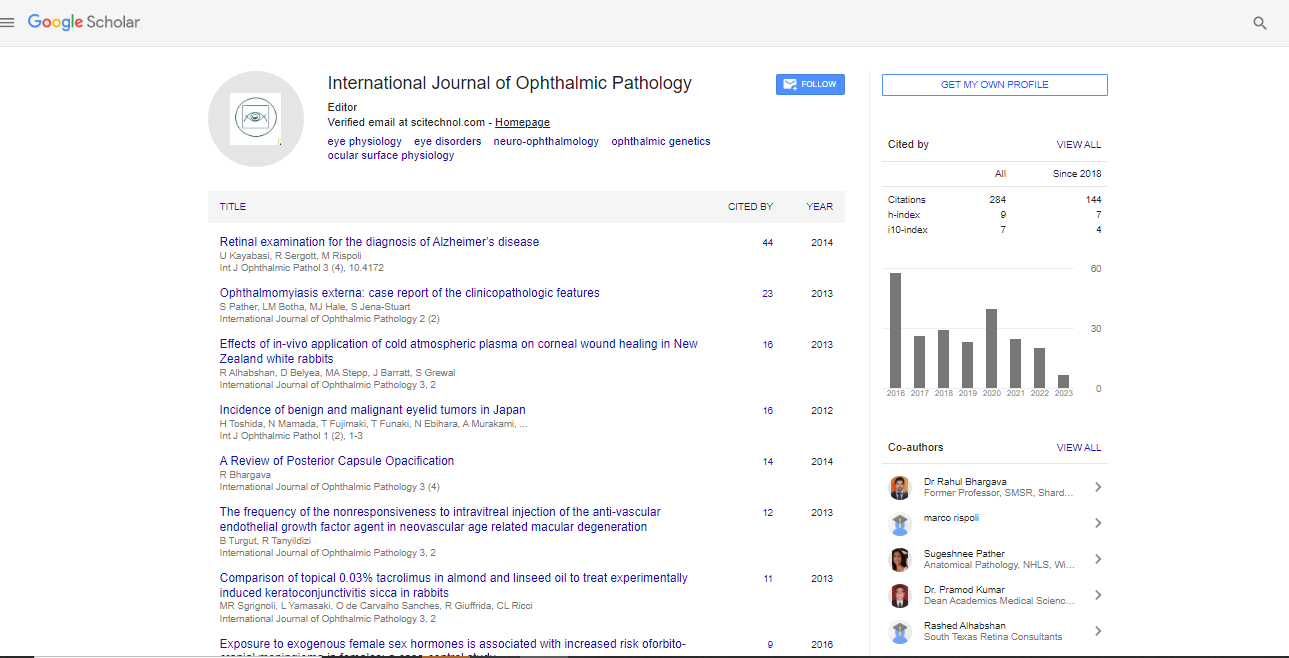Review Article, Int J Ophthalmic Pathol Vol: 10 Issue: 0
Anterior Chamber Depth Characteristics Clinical and Modifying Factors
Lee Fidler*
Department of Medicine, University Health Network, Toronto, Canada
*Corresponding Author: Lee Fidler
Department of Medicine, University Health Network, Toronto, Canada
E-mail: lee.fidler72@utoronto.ca
Received: October 05, 2021 Accepted: October 18, 2021 Published: October 27, 2021
Citation: Fidler L (2021) Anterior Chamber Depth Characteristics Clinical and Modifying Factors. Int J Ophthalmic Pathol S4.
Keywords: Anterior Chamber Depth, Corneal Thickness, Eye
Introduction
Anterior Chamber Depth (ACD) assumes a significant part in a few eye conditions, including incendiary eye processes, keratoconus, endothelial cell density loss, oxidative pressure in endothelial cells, glaucoma careful intercessions, phacoemulsification medical procedure, front chamber measurements, intraocular focal point (IOL) equation estimations and careful post refractive blunders.
ACD analyzes to the distance between the corneal endothelium to the front point of convergence case. A couple of makers might fuse the corneal thickness (CT) in this term, growing around 0.5mm, contrasting with the ordinary CT in mm. But this isn’t an understanding, it not set in stone as ACD-CT.
Discussion
ACD changes with age and sex. It has an inverse comparing association with age, and directly relative association with the front chamber point (ACA), and center length (AL). Furthermore, for every millimeter extension in AL the ACD distance increases by 0.07 mm, and by reliably expansion in a patient’s life the ACD lessens by
0.005 mm. This provoked the going with conditions; surveyed ACD (3.339 - 0.005(age in years)) and ACD. Other uncovered speeds of ACD shallowing every year have been depicted, by Xu in the Beijing Eye Study at 9 μm/year Fernandez-Vigo by 10.4 μm/year, Rufer 11.5 μm/year, Sun by 11.9 μm/year Sang by 15 μm/year and Yan by 17 μm/ year. The congruity of this issue, however the colossal assortments recently portrayed, lies in the young individual that gets an IOL. Given their theoretically long-future, ACD decrements impact the tolerability of the point of convergence [1-3].
Regardless these insights, wide ACA is connected 80 with a more significant premier chamber (AC), longer AL and higher corneal power, as shown in the Gutenberg Health Study. In a partner report differentiating the AC in kids and adults, kids had basically more significant ACD, longer cover scleral-nudge distance and greater corneal twists. On account of current advancement, there are a couple of techniques in chief chamber assessment [4]. Typically, a couple of techniques are certainly more exact than others. Hoffer and Savini analyzed which were the most definite systems. By checking out the more prepared of them, manual optical pachymeter, versus mode A ultrasound. Besides, pachymetry versus partial clarity inferenciometry (PCI, similar to IOL Master). They found that mode A ultrasound gave more restricted ACD readings, related to the ultrasound speed, across the particular thickness between the cornea and liquid humor. Optical pachymetry wind up being comparatively essentially as unequivocal as PCI, existing only a minor and not quantifiably tremendous differentiation among them. Thusly, thinking that for definite ACD assessment, optical techniques, for instance, PCI and standard pachymetry will be the preferred procedures in securing this assessment [5].
Conclusion
While using PCI contraptions (IOL Master 500 or IOL Master 700) versus Scheimpflug camera procedures (Pentacam AXL), the vulnerability remained if these had extraordinary arrangement. Believe it or not, the exactness for these methods in getting ACD was similarly cautious. Notwithstanding the way that they might change in the collection of various limits, for instance, AL (where IOL Master devices excell) or corneal curves (where Pentacam AXL was shown more exact). Various other ophthalmological examination evaluations may be gotten from the front chamber, for instance, the Van Herick strategy for iridocorneal point appraisal. Lately, a more state-of-the-art ‘Van Herick Plus’ procedure was portrayed by Sihota for unexpectedly assessed ACD and point. Since the below average some part of the front chamber is more oftenly closed than the transient or nasal section, a short vertical light column riding the inadequate limbus and not showing up at the understudy (to hinder miosis that might open the fact of the matter) was most certainly more fragile than standard Van Herick system and it had a nice association with premier piece optical clarity tomography (AS-OCT): This technique could be used for more careful assessing 110 methodologies for eyes requiring full gonioscopy for iridocorneal point appraisal .
References
- Hashemi H, Yekta A, Khodamoradi F, Aghamirsalim M, Asharlous A, et al. (2019) Anterior chamber indices in a population based study using the Pentacam. Int Ophthalmol 39: 2033-2040.
- Shrivastava AK, Behera P, Kacher R, Kumar B (2019) Effect of anterior chamber depth on predictive accuracy of seven intraocular lens formulas in eyes with axial length less than 22 mm. Clin Ophthalmol 13: 1579-1586.
- Xu L, Cao WF, Wang YX, Chen CX, Jonas JB (2008) Anterior chamber depth and chamber angle and their associations with ocular and general parameters: the Beijing Eye Study. Am J Ophthalmol 145: 929-936.
- Sun JH, Sung KR, Yun S-C, Cheon MH, Tchah HW, et al. (2012) Factors associated with anterior chamber narrowing with age: an optical coherence tomography study. Invest Ophthalmol Vis Sci 53: 2607-2610.
- Sng CC, Foo LL, Cheng CY, Allen JC, He M, et al. (2012) Determinants of anterior chamber depth: the Singapore Chinese Eye Study. Ophthalmol 119: 1143-1150.
 Spanish
Spanish  Chinese
Chinese  Russian
Russian  German
German  French
French  Japanese
Japanese  Portuguese
Portuguese  Hindi
Hindi 